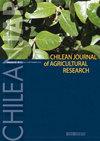Gas exchanges and growth of soybean as affected by irrigation depths and soil compaction
IF 1.7
4区 农林科学
Q2 Agricultural and Biological Sciences
引用次数: 0
Abstract
The availability of water above compacted soil layer improves the performance of soybean ( Glycine max (L.) Merr.) gas exchanges. However, studies do not address the responses of the photosynthetic process of soybean in compacted soil. The objective of this study was to evaluate the dynamics of gas exchange, growth and performance of soybean in compacted soil with poor irrigation. The experiment was conducted in a greenhouse with a completely randomized design in a 3 × 4 split plot for three soil densities (1.0 ± 0.013, 1.15 ± 0.022 and 1.30 ± 0.035 Mg m -3 ) and four daily water depths (4.0, 5.0, 6.0 and 7.0 mm d -1 ) with three replicates. Net photosynthesis rate (A), transpiration rate (E), stomatal conductance (g s ), water use efficiency (WUE), instantaneous water use efficiency (iWUE), net assimilation rate, growth rate of shoot and root, relative growth rate of shoot and root, shoot biomass, root biomass at different layers (upper, compacted and lower), total root biomass and pod biomass were evaluated. The 4.0 and 5.0 mm d -1 water depths provided higher WUE and iWUE, but not soybean biomass accumulation; with these water depths and 1.15 Mg·dm -3 , gas exchange and accumulation of shoot biomass improved. From 45 to 65 d after emergence (DAE), shoot growth rate had a maximum peak at 7.0 mm d -1 in compacted soil. The growth rate and relative growth rate of soybean roots had smaller increases in biomass at 65 DAE. Daily water depths of 4.0 and 5.0 mm d -1 provided the best results in terms of WUE, however, it did not reflect an accumulation in soybean biomass. In these depths, soil compaction at 1.15 Mg m -3 provided an increase in g s , E, and A.灌水深度和土壤压实对大豆气体交换和生长的影响
本文章由计算机程序翻译,如有差异,请以英文原文为准。
求助全文
约1分钟内获得全文
求助全文
来源期刊
CiteScore
3.00
自引率
11.80%
发文量
60
审稿时长
6 months
期刊介绍:
ChileanJAR publishes original Research Articles, Scientific Notes and Reviews of agriculture, multidisciplinary and agronomy: plant production, plant protection, genetic resources and biotechnology, water management, soil sciences, environment, agricultural economics, and animal production (focused in ruminant feeding). The editorial process is a double-blind peer reviewing, Editorial Office checks format, composition, and completeness, which is a requirement to continue the editorial process. Editorial Committee and Reviewers evaluate relevance and scientific merit of manuscript.

 求助内容:
求助内容: 应助结果提醒方式:
应助结果提醒方式:


